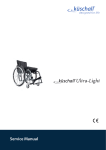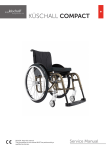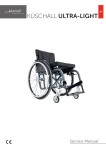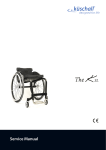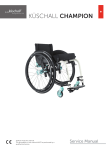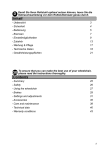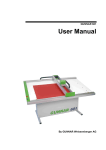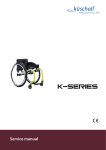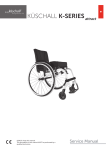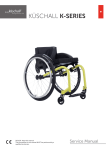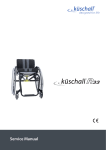Download Service Manual
Transcript
Service Manual Service Manual Table of contents General.......................................................................................................................... 4 Introduction 4 Spare parts and adaptations 4 Fastening with hexagon socket bolts 4 Torque 5 Checks 5 Identifying and repairing faults 5 Frame .......................................................................................................................... 6 Rear frame 7 Front frame 7 Retaining lever 7 Seat................................................................................................................................ 8 Seat height front (SHv) 8 Seat height rear (SHh) 9 Seat width (SB) 9 Seat depth (ST) 9 Backrest....................................................................................................................... 11 Backrest height 11 Adjustable-angle backrest 12 Replacing push handles / push handles and backrest 14 Legrests....................................................................................................................... 18 Footrests..................................................................................................................... 19 One-piece footrest 19 Two-piece footrest 21 Two-piece footrest, adjustable-angle 21 Sideparts..................................................................................................................... 22 Clothes guard/mudguard 22 Siderests 23 Front wheels................................................................................................................ 26 Castor fork 26 Special housing guides 27 Rear wheels................................................................................................................. 28 Adjusting the seat height rear 28 Tipping stability 28 Wheel camber 29 Adapter plate for drum brake 29 Distance sleeves for rear wheels 29 Brakes.......................................................................................................................... 30 Parking brakes 30 Drum brake 31 Options & accessories................................................................................................ 32 Antitipper 32 Tipper aid 33 Cane holder 33 Transit wheels 34 3 © Küschall AG, Schweiz | 2011-07 Service Manual General Introduction This Service Manual contains all the technical information necessary for the inspection, configuration or repair of a Küschall® wheelchair. To maintain the necessary levels of safety and reliability, every wheelchair must be thoroughly examined once a year. Some aspects of the assembly and configuration of the wheelchair require a high level of expertise. These assembly instructions therefore break the various tasks down into 3 categories: Requirement Symbol Easy – technical understanding required Medium – technical knowledge required Difficult – technical knowledge and expertise in assembling wheelchairs required The required tools and their sizes are listed before the instructions. The various torque values with which the nuts are to be tightened are also specified in the instructions. A torque spanner must be used, in order to comply with the specified torque values. Tool Symbol Allen key à 3, 4, 5 Torx wrench ß 10 Phillips head screwdriver Ò Open-end spanner Socket spanner/Box spanner 8, 9, 10, 18 8, 10, 19, 22 Spare parts and adaptations All spare parts may be obtained from the Küschall customer service department. An electronic spare parts catalogue can be found at www.kueschall. com. Only original spare parts may be used. The written authorisation of Küschall AG must be obtained before installing additional adaptations on a Küschall wheelchair. Fastening with hexagon socket bolts Hexagon socket bolts are not designed to withstand an excessive application of force. When tightening or undoing a hexagon socket bolt, force should be applied to the nut wherever possible to avoid damaging the bolt. Tightening and undoing Turn the nut using a socket spanner (only use an open-end spanner if there is insufficient space), using the Allen key simply to stop the bolt turning. Tightening and undoing when no nut is present If a hexagon socket bolt is screwed directly into a thread, the bolt must be tightened using the Allen key. 4 © Küschall AG, Schweiz | 2011-07 Service Manual Torque All bolts must be tightened with the torque specified in the following instructions. Checks Visual check Check the entire frame for cracks, especially in the vicinity of joints and weld seams (frame, axle clamp components, back). Check of the bolts Check that all bolts have been tightened with the torque specified in the instructions. Several bolts are secured with adhesive. If these are loosened, they have to be secured with j adhesive again. The most important bolts with adhesive are: • Central bolt on the cross (high-strength adhesive, 3 Nm) • Longitudinal stopping bolts on the seat edge (=bolts, which come to rest on either side of the rear seat locking mechanisms when the seat is unfolded) (low-strength adhesive, 13 Nm) Identifying and repairing faults Fault Possible cause Action Incorrect tyre pressure on one rear wheel Correct tyre pressure One or more spokes broken Replace broken spoke(s) Spokes tightened unevenly Front wheel bearings are dirty or damaged Support bearings in forks faulty Tighten loose spokes Clean or replace the bearings Replace the support bearings Steering error or trail angle, left and right, uneven Adjust steering error or trail angle Rear wheels are mounted too far forwards Backrest angle too large Incorrect tyre pressure in one or both rear tyres Brake setting incorrect Mount the rear wheels further back Reduce backrest angle Mount the adapter plate lower on the side profile Correct tyre pressure Correct brake setting Tyre pressure in rear tyres is too low Correct tyre pressure The rolling resistance is very high Rear wheels not parallel Make rear wheels parallel Drum brake set too narrow Bearings are dirty or faulty Set the drum brake Replace the bearings The front wheels wobble when moving fast Too little tension on the clevis pin housing Tighten the nut on the castor fork slightly The wheelchair does not travel in a straight line The wheelchair tips too easily The brakes are gripping poorly or asymmetrically Seat angle too large Front wheel has worn smooth Replace front wheel The front wheel is stiff or stuck Bearings are dirty or faulty Replace the bearings The wheelchair is very difficult to unfold The backrest cover is too tight Loosen the topmost Velcro band of the backrest cover a little Left and right side of the wheelchair can be moved in parallel to one another Longitudinal stopping bolts on the seat edge are loose Tighten the longitudinal stopping bolts on the seat edge 5 © Küschall AG, Schweiz | 2011-07 Service Manual Frame Frame 8 Rear frame a à 13 Nm b à 7 Nm Retaining lever a à 4 Nm 7 Cross Front frame a à 13 Nm b à 7 Nm c à 7 Nm Upper connecting tube 1 Lower connecting tube 2 Seat locking mechanism Longitudinal stopping bolts 3 4 8 2 2b 2c 1b 2a 4b 5 1 6 7 2 5 1b 4c 4b 1a 3 4a 1a 6 4 4a 6 © Küschall AG, Schweiz | 2011-07 Service Manual Frame Rear frame Replacing the rear frame Tool: à 5 Difficulty: 10 0 Remove backrest. 0 Loosen and remove bolts a and b. 0 Pull out rear frame to the back. 0 Push the rear frame onto the upper and lower connecting tubes. 0 Reinsert and tighten bolts a and b. Front frame Replacing the front frame Difficulty: Tool: à 3, 4, 5 10 0 Disassemble brakes. 0 Loosen and remove bolts a and b on both sides. (On abduction frames, the connecting tube is welded onto the front frame; in this case loosen a and b.) If a flip to back side rest is fitted, also loosen c. 0 Pull out front frame to the front. 0 Remove seat locking mechanism with threaded insert from old front frame and fit it on the new front frame, Chap. Seat; ‹Turning the seat locking mechanism›. 0 Push the front frame onto the upper and lower connecting tube. 0 Reinsert and tighten bolts a, b (if required c) on both sides. 0 Set the castor fork angle, Chap. Front wheels; ‹Setting the steering error angle›. Retaining lever Replacing the retaining lever Difficulty: Tool: à 3, 4, 5 10 0 With mudguard or clothes guard, fixed: remove a and b, with mudguard or side rest, insertable and siderest, foldable: remove a and b. 0 Remove bolt a. 0 Pull the retaining lever from the upper connecting tube . 0 Remove sleeve b. 0 Push the new retaining lever over the upper connecting tube . 0 Position sleeve b with wide edge in joint c. 0 Secure retaining lever with bolt a. 0 With mudguard or clothes guard, fixed: reinsert and tighten bolts a and b, with mudguard or side rest, insertable and side rest, flip to back: reinsert and tighten bolts a and b. 7 © Küschall AG, Schweiz | 2011-07 Service Manual Seat Seat Seat height front (SHv) Options for changing the SHv: • Replace front wheel with larger or smaller one or fit it at another position on the castor wheel, Chap. Front wheels ‹Replacing the front wheel›. • • Replace castor fork with a larger or a smaller one, Chap. Front wheels; ‹Replacing the castor fork›. Fit it high/low with the housing guide ‹Hemi›, Chap. Front wheels; ‹Special housing guides›. Seat height front with respect to fork size, castor fork size and position in the fork Castor fork [inch] SHv [cm] 41 3'' 42 3'' 43/44 4'' 3'' 45 4'' 3'' 46 5'' 4'' 3'' 47 5'' 4'' 3'' 48/49 6'' * 5'' 4'' 3'' 50 6'' * 5'' 4'' 3'' 51 7'' * 6'' * 5'' 4'' 7'' * 6'' * 5'' 7'' * 6'' * 52 53/54 (Assumption: Seat depth = 40 cm, seat angle = 5 cm) fitted high: SHv - 3 cm fitted low: SHv + 3 cm * 6’’ and 7’’ front wheels cannot be used on the Ultra-Light dynamic frame (80°), if a 2-part angled footrest is fitted. 8 © Küschall AG, Schweiz | 2011-07 Service Manual Seat Seat height rear (SHh) Options for changing the SHh: • Replace rear wheel with a larger or a smaller one • Change the position of the adapter plate, Chap. Rear wheels. Seat height rear with respect to the rear wheels and positioning on the frame SHh [cm] 22’’ Rear wheel size [inch] 24’’ 25’’ 37 1 38 2 39 3 1 40/41 4 2 26’’ 1 2 3 4 5 6 7 8 9 10 11 12 1 42 5 3 2 1 43 6 4 3 2 44 7 5 4 3 45/46 8 6 5 4 47 9 7 6 5 48 10 8 7 6 49 9 8 7 50 10 9 8 Seat width (SB) SBs range from 28 - 50 cm. Once the SB is specified, it is very difficult to change it: the cross struts, backrest cover (on standard backs) and, on some configurations, the footrests must be replaced. Seat depth (ST) STs range from 32 - 50 cm. To reduce the ST, the cross struts must be shortened and a new appropriately sized seat cover fitted. At an ST ≥ 40 cm, the frame can be shortened. To enlarge the ST, new cross struts, a new appropriately sized seat cover and, depending on the ST, a new frame must be installed. 9 © Küschall AG, Schweiz | 2011-07 Service Manual Seat Replacing the seat cover Tool: ß 10 Difficulty: 1 Loosen bolts and remove plug . 2 Remove seat cover including plastic rods. 0 Position new seat cover. Adjust seat cover to width SB + 25 mm. 0 Retighten bolts and plug . 1 2 à 4 Nm Turning the seat locking mechanism If the seat edge can be too easily removed from the seat locking mechanisms, either the front two or all four seat locking mechanisms can be rotated by 180°: Tool: à 3 Difficulty: 0 Loosen bolt in seat locking mechanism . 0 Turn seat locking mechanism by 180°. 0 Secure bolt with adhesive (low-strength). 0 Retighten the bolt. Screw out the bolt only to the extent that the seat locking mechanism i can be turned as otherwise the threaded insert can move and is then difficult to re-position. à 4 Nm 10 1 © Küschall AG, Schweiz | 2011-07 Service Manual Backrest Backrest Backrest height The backrest height can be changed by fitting the telescopic tubes into another position in the backrest tubes. If this setting option is insufficient, the telescopic tubes can be replaced. Adjusting the height of standard backrests Tool: à 3, 4, 6 Difficulty: 8, 10 3 Push the backrest cover upwards and remove the bolt on both 1 sides. Push the push handles upwards or downwards until you reach the required height. Replace the bolt and tighten. i 2 If this setting range is insufficient, use new push handle tubes. If the backrest height was changed considerably, a new backrest i cover may have to be fitted. Adjusting the height of Velcro® adjustable backrests Difficulty: Tool: à 3, 4, 6 8, 10 Remove backrest cover and move the Velcro® bands until bolt is visible. Remove bolt and move the push handle tube to the required height. Insert bolt into the appropriate hole and tighten. 4 1 If the backrest height is changed considerably, the push handles must i be replaced. An additional Velcro® band may have to be fitted or one may have to be removed. 3 2 11 © Küschall AG, Schweiz | 2011-07 Service Manual Backrest Adjustable-angle backrest In order to make the backrest angle adjustable, an adjustable-angle backrest can be fitted. Backrest angle Position Deviation from standard backrests Angle between backrest and seat 1 12° 102° 2 8° 98° 3 4° 94° 4 0° 90° 5 -4° 86° 6 -8° 82° 7 -12° 78° Fitting an adjustable-angle backrest Difficulty: Tool: à 3, 4, 5 8, 10 10 Shorter rear frame (variant III) required. 7 Push the lower joint pin into the rear frame and fix it using a bolt. Secure backrest tube to the upper joint pin using a bolt. Assemble the upper and lower joint pins and and secure with bolt (13 Nm). Retighten the bolt . 6 Set the desired backrest angle and secure in the nearest hole using 10 bolt . Push the single Velcro® band and then the other Velcro® bands 9 and end band over the backrest tube . Push the push handle into the telescopic tube and fix at the 3 Secure end band on the telescopic tube with a bolt. 5 4 required height. 1 2 8 à 13 Nm à 13 Nm 12 © Küschall AG, Schweiz | 2011-07 Service Manual Backrest Setting the backrest angle Difficulty: Tool: à 5 10 10 Remove the backrest cushion and push the Velcro® bands upwards, until the backrest joint is invisible. 2 Remove the bolt . 3 Set the desired backrest angle, insert the bolts in the nearest hole and tighten. 0 Retighten the bolt . 3 0 Perform the same setting on both sides. 2 1 4 Visual check 5 By looking from the side check that both backrest tubes are level and thus that the same angle has been set on both sides. à 13 Nm à 13 Nm Fitting the joint for a folding backrest Difficulty: Tool: à 4, 5 10 Shorter rear frame (variant III) required. Set the desired backrest angle, insert bolt in the nearest position (Pos. 1, 2 or 3) and tighten (13 Nm). (With the curved backrest tubes, other positions can be achieved in addition to the 3 positions specified.) 1 0 Fold down upper joint pin with intermediate backrest tube . 2 Push the joint housing into the rear frame and fit it using a bolt (13 Nm). Backrest angle à 13 Nm Position 1 (rear position): 82°, with curved backrest tube 90° Position 2 (mid position): 86°, with curved backrest tube 94° Position 3 (front position): 90°, with curved backrest tube 98° 2 3 4 13 © Küschall AG, Schweiz | 2011-07 Service Manual Backrest Replacing push handles / push handles and backrest If the push handles are replaced with a different type of push handles, e.g. height-adjustable ones, it can happen that the rear frame must also be replaced. Changing the backrest height can also mean that the configuration of the Velcro® bands must be changed. Fitting standard push handles Difficulty: Tool: Ò Ã 3, 4, 5 8, 10 1 Secure the telescopic tube to the rear frame at the required height. 4 2 Push the backrest bands and end band onto the telescopic tube , end band first. 3 Secure end band on the telescopic tube with a bolt. 3 2 1 Fitting height adjustable integrated push handles Difficulty: Tool: Ò Ã 3, 4, 5 8, 10 Special rear frame required for RH 30 – 46.5 (variant II) Push lower telescopic tube and upper telescopic tube into one 3 another and insert bolt. Secure pre-assembled element (telescopic tubes and ) at the required height on the rear frame with a bolt (7 Nm). 6 2 7 Push the Velcro® bands and end band onto the telescopic tubes. Using the clamp bolt secure the height adjustable push handles 5 through the telescopic tube . Push in push handle completely. Secure end band on the telescopic tube with a bolt. 14 1 4 © Küschall AG, Schweiz | 2011-07 Service Manual Backrest Fitting height adjustable, rear set push handles Tool: Ò Ã 3, 4, 5 Difficulty: 8, 10 The Velcro® bands may have to be replaced with narrower ones, as space is required to secure the holder on the telescopic tube. Secure the telescopic tube to the rear frame at the required 6 height. 4 Press the cover cap onto the end of the telescopic tube. Push the Velcro® bands onto the telescopic tube. Push the holder onto the telescopic tube and fix in place by 2 tightening the clamp bolts (13 Nm). Fit end band onto the telescopic tube and secure with a bolt. 5 Attach protective cushion. 3 1 Fitting angle-adjustable backrest with height-adjustable push handles Difficulty: Tool: Ò Ã 3, 4, 5 8, 10 10 7 Shorter rear frame (variant III) required. 11 Push the lower joint pin into the rear frame and fix it using the bolts. Fit backrest tube onto the upper joint pin using bolts. Assemble the upper and lower joint pins and and secure with a bolt . Set the desired backrest angle and secure in the nearest hole using a nut and bolt . Retighten the bolt . 10 3 5 4 6 2 Push the single Velcro® band and then the other Velcro® bands 9 and end band over the backrest tube . Push in push handle completely. Using the clamp bolt a fit the height-adjustable push handles 1 8 through the telescopic tube . Fit end band onto the telescopic tube with a bolt. à 13 Nm à 13 Nm 15 © Küschall AG, Schweiz | 2011-07 Service Manual Backrest Backrest with adjustable backs with respect to push handles Backrest height (RH) Standard push handles Folding push handles Height-adjustable integrated push handles Velcro bands 30 S S S XXS S XXS S 4B S 31.5 S S S XS S XS S 4B S 33 S S S S S S S 4B S 34.5 S S L M S M L 4B S 36 S S L M S M L 4B S 37.5 S S L M S M L 4B S 39 S/M S/M L M S M L 4B M 40.5 S/M S/M L M S M L 4B M 42 S/M S/M L M S M S 6B M 43.5 M M L L L L S 6B M 45 M M L L L L S 6B M 46.5 M M L L L L L 6B M 48 M M L L L L L 6B L 49.5 M M L L L L L 6B L 51 M M L L L L L 6B L 2B 4B Assumption: No stabilising bar fitted Angle-adjustable backrest with adjustable backs with respect to push handles Folding push handles Height-adjustable integrated push handles Velcro bands L 1B+2B S S L 1B+2B S S S 1B+4B S S L S 1B+4B S S L S 1B+4B S S L L 1B+4B S 30 S S S 31.5 S S 33 S S 34.5 S 36 S 37.5 S 39 S/M S/M L 40.5 S/M S/M L 42 S/M S/M L 43.5 M M L 45 M M L 46.5 M M L 48 M M L different for every backrest height Backrest height (RH) Standard push handles L 1B+4B M L 1B+4B M L 1B+4B M S 1B+6B M S 1B+6B M S 1B+6B M S 1B+6B L 49.5 M M L L 1B+6B L 51 M M L L* 1B+6B* L 2B 4B Assumption: No stabilising bar fitted * For RH51 with height-adjustable integrated push handles: =S, =2x4B 16 © Küschall AG, Schweiz | 2011-07 Service Manual Backrest Foldable angle-adjustable backrest with respect to push handles Backrest height (RH) Standard push handles Folding push handles Height-adjustable integrated push handles S S S S 31.5 S S S S S 33 S S S S S 34.5 S S S S 36 S S S 37.5 S S S 39 S S L S S L 42 S S L 43.5 M M L 45 M M L 46.5 M M L 48 M M L S S S S S S L L different for every backrest height S different for every backrest height 30 40.5 Velcro bands L L 2B S L 2B S L* 2B S L 2B M S 4B M S 4B M S 4B M S 4B M L 4B M L 4B L 49.5 M M L L L 4B L 51 M M L L L 4B L 2B 4B Assumption: No stabilising bar fitted * For RH37.5 with height-adjustable integrated push handles: =S und =2B+4B Additionally a band is fixed close to the backrest joint. The band is of different length according to the seat width (SB). There are three lengths: SB 28-36 short, SB 38-44 medium, SB 46-50 long 17 © Küschall AG, Schweiz | 2011-07 Service Manual Legrests Legrests Legrests with angle measurements of 70, 80 and 90° are available. Replacing the locking mechanism Tool: ß10 à 3 Difficulty: Screw off unlocking lever manually. Remove hinge pin . Loosen bolts . Remove locking mechanism and replace with a new one. 6 Reinsert bolts and tighten. Screw in the hinge pin again. Screw the unlocking lever back on manually. Setting the locking lever Tool: à 3, 5 Difficulty: It must be possible to move the unlocking lever 1-2 mm freely forward and back, without having to move the bolt . This guarantees that the bolt is sitting optimally in the counterpiece . If this free mobility is greater or smaller than specified, the unlocking lever must be reset: Screw off the unlocking lever manually. Loosen the hinge pin (do not remove). 1 2 3 4 5 Screw bolt in deeper to reduce movement or screw bolt further out to increase movement. à 3 Nm Set it so that the pin can move freely by 1-2 mm. à 3 Nm Retighten the hinge pin again. Screw the unlocking lever back on manually. 18 © Küschall AG, Schweiz | 2011-07 Service Manual Footrests Footrests One-piece and two-piece footrests are available. One-piece footrest Replacing the footplate Difficulty: Tool: à 4 10 Loosen bolts on both sides. à 13 Nm 1 Remove footplate and replace with a new one. Re-insert bolts and tighten. 2 Disassembling/fitting the footrest Difficulty: Tool: à 4 8 1 Remove bolts on both sides. 2 Pull out the footrest. 1 3 Insert new footrest. 4 Tighten bolts on both sides at the same height and in the required position. à 4 Nm Adjusting the height of the footrest Difficulty: Tool: à 4 8 1 Remove bolts on both sides. 2 Hold the telescopic tubes with both hands and push the footrest into the required position. 1 3 Insert bolts into the nearest hole on both sides and at the same height and tighten securely. à 4 Nm 19 © Küschall AG, Schweiz | 2011-07 Service Manual Footrests Centring and adjusting the angle Difficulty: Tool: à 4 10 1 Loosen bolts and slightly. 2 1 Set the same distance from the side tube to the footplate on both sides. 2 Set the required footplate incline. Re-tighten bolts (fixed side of the footplate). Turn the little tube on the moving side of the footplate such that it engages properly. à 13 Nm 3 à 13 Nm Tighten bolts . Changing the position of the footrest (set to rear – set to front) Difficulty: Tool: à 4 1 Loosen bolts on both sides and remove. 10 à 13 Nm 1 2 Turn the footplate with the clamp component. 3 Re-insert bolts and tighten. 20 © Küschall AG, Schweiz | 2011-07 Service Manual Footrests Two-piece footrest Tool: à 4 Difficulty: 8 Disassembling/fitting footrests 1 Remove bolts on both sides. 2 Pull out footrests. 1 3 Push the new footplates into the frame and at the required height. 4 Insert bolts into the nearest hole on both sides and at the required height and tighten. à 4 Nm Adjusting the height of the footrests Difficulty: Tool: à 4, 8 Remove bolts . 1 Push the footplates into the required position. Insert bolts into the nearest hole on both sides and at the required height and tighten. à 4 Nm Changing the position of the footrests (set to rear – set to front) Tool: à 5 Difficulty: 1 Remove bolts . 2 Pull the footrests away downwards and replace. 3 Re-insert bolts and tighten. 1 à 7 Nm Two-piece footrest, adjustable-angle Adjusting the angle Tool: à 5 Difficulty: 1 Loosen bolt . 2 Change the angle of the footrest until it reaches the required position. Retighten bolt . 1 à 13 Nm 21 © Küschall AG, Schweiz | 2011-07 Service Manual Sideparts Sideparts Clothes guard/mudguard 1 Fitting the clothes guard/mudguard Tool: à 3 Difficulty: 8 1 Fit side fastenings onto the frame. 2 Fit clothes guard/mudguard with bolts and nuts onto the side fastenings (4 Nm). CAUTION! j Fit the mudguard such that it is positioned either < 8 mm or > 25 mm 2 above the tyres, to avoid the risk of trapping one’s fingers. 1 Adjusting the clothes guard/mudguard Tool: à 3 Difficulty: 8 à 4 Nm 1 Loosen bolts . Move the clothes guard/mudguard . à 4 Nm 0 Retighten bolts . or 1 2 Loosen and remove bolts . 2 3 Re-fit clothes guard/mudguard in another position. 1 Fitting and adjusting the removable mudguard Difficulty: Tool: à 3, 4, 5 10 1 Fit side fastening element with bolts a and b. 6 5 2 Insert mudguard in the side fastening element . Adjust the height 3 by loosening the three bolts on the end stop . 3 If the edge of the mudguard does not run evenly over the tyre, loosen 4 bolts / and push the mudguard into the required position. Retighten bolts /. CAUTION! j Fit the mudguard such that it is positioned either < 8 mm or > 25 mm above the tyres, to avoid the risk of trapping one’s fingers. 2a 1 2b a à 4 Nm b à 7 Nm à 7 Nm à 7 Nm 22 © Küschall AG, Schweiz | 2011-07 Service Manual Sideparts Siderests In general a torque of 7 Nm is used to fit the side rests. Fitting a flip to back side rest in the frame colour Difficulty: 8 Tool: à 3, 4, 5 10 4 0 Fit the side fastening element with bolt 1a . 5 6 0 For bolt 1b, bore a hole with a diameter of 6 mm through the front 3 frame (hole already made in the connecting tube) and fit bolt 1b. 9 0 Screw the sleeve and bolt onto the rear fastening element . 7 8 2 0 Fit rear fastening element and clip loosely with bolts and sleeves (normal rear frame: 1.7 cm beneath the upper edge of the frame reinforcement, on a shortened rear frame, directly flush with the upper edge of the frame reinforcement). 1a 1b 0 Mount the side rest , position rear fastening element precisely. 0 Attach the wedge and headless bolt . The sleeves are different for flip to back side rest in frame colour i and flip to back side rest with engagement mechanism. To enlarge the distance between the wheels additionally, a different i adapter sleeve, which is mounted from the inside, has to be applied. Fitting flip to back side rest with locking mechanism Difficulty: Tool: à 3, 4, 5 8 10 0 Fit the side fastening element with bolt 1a . 4 0 For bolt 1b, bore a hole with a diameter of 6 mm through the front frame (hole already made in the connecting tube) and fit bolt 1b. 3 0 Screw the sleeve and bolt onto the rear fastening element . 9 0 Fit rear fastening element and clip loosely with bolts and 8 sleeves (normal rear frame: 1.7 cm beneath the upper edge of the frame reinforcement, on a shortened rear frame, directly flush with the upper edge of the frame reinforcement). 5 6 7 2 1a 0 Mount side rest , position rear fastening element precisely. 0 Attach the wedge and headless bolt . 1b The sleeves are different for flip to back side rest in frame colour i and flip to back side rest with engagement mechanism. To enlarge the distance between the wheels additionally, a different i adapter sleeve, which is mounted from the inside, has to be applied. 23 © Küschall AG, Schweiz | 2011-07 Service Manual Sideparts Fitting side rest insertable, continuously height-adjustable Difficulty: Tool à 4, 5 10 1 Fit the side fastening element with bolts and . 2 Insert side rest into the fastening element. 0 Adjust height by adjusting the clamp component. 1 2 à 4 Nm à 7 Nm Fitting a simple swivelling armrest Tool à 4, 5 Difficulty: 1 Fit the rear fastening element. 2 Insert the armrest. 0 Adjust height by adjusting the bolt in the tube of the armrest. 24 © Küschall AG, Schweiz | 2011-07 Service Manual Sideparts Size of the clothes guard/mudguard The clothes guard and mudguard can be adjusted to suit the height of the rear wheel exactly. Two sizes of each are available. For the removable carbon mudguard there is an additional size (XL) for the two smallest rear seat hights (SHh). Clothes guard mounted fix: S L Clothes guard with respect to the position of the rear wheels with standard adapter plate (Pos. 1 to 4) or rear wheel extension (Pos. 5 and 6) SHh Rear wheel 22’’ Rear wheel 24’’ 1 2 3 4 5 6 1 2 3 4 38 L L L S S S - - - - 39 L L L S S S L L L L 40 L L L S S S L L L L 41 L L S S S S L L L 42 L L S S S S L L 43 L S S S S S L 44 L S S S S S 45 S S S S S 46 - - - - 47 - - - 48 - - 49 - - 50 - - 5 Rear wheel 25’’ Rear wheel 26’’ 6 1 2 3 4 5 6 1 2 3 4 5 6 - - - - - - - - - - - - - - L L - - - - - - - - - - - - L L - - - - - - - - - - - - S L L L L L L L L - - - - - - L S L L L L L L L L L L L L L L L L S L L L L L S S S L L L L S S L L L S S S L L L S S S L L L L S S S L L S S S S L L L S S S L L L S S S - - L L S S S S L L L S S S L L L S S S - - - L S S S S S L L S S S S L L L S S S - - - - L S S S S S L L S S S S L L L S S S - - - - - - - - - - L S S S S S L L S S S S - - - - - - - - - - L S S S S S L L S S S S 25 © Küschall AG, Schweiz | 2011-07 Service Manual Sideparts Mudguard mounted fix: S L Mudguard (mounted fix) with respect to the position of the rear wheels with standard adapter plate (Pos. 1 to 4) Rear wheel 22’’ Rear wheel 24’’ Rear wheel 25’’ Rear wheel 26’’ 1 2 3 4 1 2 3 4 1 2 3 4 1 2 3 4 41 L L S S L L L L L L L L - - - - 42 L L S S L L L L L L L L L L L L 43 L S S S L L L L L L L L L L L L 44 L S S S L L L S L L L L L L L L 45 S S S S L L S S L L L L L L L L 46 - - - - L L S S L L L S L L L L SHh 47 - - - - L S S S L L S S L L L S 48 - - - - S S S S L S S S L L L S 49 - - - - - - - - S S S S L L S S 50 - - - - - - - - S S S S L L S S Mudguard removable: S XL L Mudguard (removable) with respect to the position of the rear wheels with standard adapter plate (Pos. 1 to 4) or rear wheel extension (Pos. 5 and 6) SHh Rear wheel 22’’ Rear wheel 24’’ Rear wheel 25’’ Rear wheel 26’’ 1 2 3 4 5 6 1 2 3 4 5 6 1 2 3 4 5 6 1 2 3 4 5 6 38 L L L L S S - - - - - - - - - - - - - - - - - - 39 L L L L S S XL XL XL XL L L - - - - - - - - - - - - 40 L L L L S S XL XL XL XL L L - - - - - - - - - - - - 41 L L S S S S XL L L L L L XL XL XL XL L L - - - - - - 42 L L S S S S L L L L L L XL XL XL XL L L XL XL XL XL L L 43 L S S S S S L L L L L L XL L L L S S XL XL XL XL S S 44 L S S S S S L L L S S S L L L L S S XL XL XL XL S S 45 S S S S S S L L S S S S L L L L S S XL XL L L S S 46 - - - - - - L L S S S S L L L S S S L L L L S S 47 - - - - - - L S S S S S L L S S S S L L L S S S 48 - - - - - - S S S S S S L S S S S S L L L S S S 49 - - - - - - - - - - - - S S S S S S L L S S S S 26 © Küschall AG, Schweiz | 2011-07 Service Manual Front wheels Front wheels Replacing the front wheel Tool: à 3 Difficulty: Remove bolts , pull out wheel axle . Remove front wheel and replace with a new one or move to a new 1 position. (In the case of the Starec wheel, skater wheel, 3’’ sports wheel and the 5’’ soft roll wheel, 2 sleeves must be pushed onto the axle. These sleeves are already in place on the low-resistance wheel, the sports wheels and the pneumatic wheels.) 3 1 2 Re-insert axle and tighten bolt . 4 4 Function check There must be no play in the wheel but it must turn easily. à 4 Nm Castor fork Replacing the castor fork Difficulty: Tool: à 3 19 1 Remove bolts , wheel axle and front wheel . 2 Remove nuts and pull the castor fork from the clevis pin. Replace castor fork and secure with nut such that the fork has no play. Re-insert the front wheel. CAUTION! Do not overtighten nut , as this can damage the fork bearing. j 1 5 2 4 3 Function check Tip the wheelchair backwards 90° so that it is lying on the backrest and rear wheels. A Turn the fork up (A) and allow it to swivel down. The fork is adjusted correctly if it just passes the lowest point and stops there (B). B If the fork moves back when in its lowest position (C), it has not been tightened enough. There is a risk that the front wheels will start to wobble when travelling at high speeds. C 27 © Küschall AG, Schweiz | 2011-07 Service Manual Front wheels Setting the steering error angle Difficulty: Tool: Ã5 10 1 Loosen bolts and nuts . 1 Hold spirit level against the clevis pin housing . Turn the bolt until the clevis pin housing is vertical. 2 Retighten bolts and nuts . 3 90˚ CAUTION! j It is important that the settings on the left and right are precisely the 4 same. à 13 Nm Correcting the trail angle Difficulty: Tool: Ã5 10 1 1 Loosen bolts and nuts . Remove clevis pin housing . 4 3 Attach adjustment template / (for toe-out: insert template at the bottom , for toe-in: insert template at the top ). Fit clevis pin housing . Set the angle, Chap. Front wheels; ‹Setting the steering error angel›, ‹Correcting the trial angel›. 2 2 5 5 Special housing guides Fitting special housing guide for smaller SHv (housing guide, fitted high) Difficulty: Tool: Ã5 10 Remove clevis pin housing . Remove standard housing guide. 3 Attach bolt . 1 Fit special housing guide ‹high›. Fit clevis pin housing . 2 Set the angle,, Chap. Front wheels; ‹Setting the steering error angel›, ‹Correcting the trial angel›. à 13 Nm à 13 Nm Fitting special housing guide for larger SHv (housing guide, fitted low) Difficulty: Tool: Ã5 10 Remove clevis pin housing . Remove standard housing guide. Fit special housing guide ‹low›. Fit clevis pin housing . Set the angle, Chap. Front wheels; ‹Setting the steering error angel›, ‹Correcting the trial angel›. 28 1 2 © Küschall AG, Schweiz | 2011-07 Rear wheels Rear wheels Adjusting the seat height rear Difficulty: Tool: à 5 10, 19, 22 à 13 Nm Loosen the bolt of the adapter sleeve and bolts . Remove bolts and move the adapter plate into the required à 33 Nm position. 4 Insert bolts at the appropriate height. à 13 Nm Insert the bolt of the adapter sleeve . Tighten bolts and . 1 Tighten the bolt of the adapter sleeve . Perform the same setting on both sides. 2 After the SHh is changed, the steering error angle must be checked i Chap. Front wheels; ‹Setting the steering error angel›, ‹Correcting 3 the trial angel› and with a wheel camber of 3° the angle of the rear wheels must also be checked, Chap. Rear wheels; ‹Changing the wheel camber›. After the SHh is changed, distance sleeves may also have to be fitted i in order to increase the distance to the rear wheels. Tipping stability The tipping stability is influenced by the rear wheel being fitted further forward or further backward on the adapter plate. The further back the adapter sleeve is fitted, the greater the tipping stability of the wheelchair. If the rear wheel is to be fitted even further back, a rear wheel extension can be fitted to increase the tipping stability even more. Adjusting the position of the rear wheel on the adapter plate Difficulty: 19, 22 Tool: Remove the adapter sleeve . 1 1 2 2 Set the adapter sleeve at the required position in the adapter plate and tighten the nut securely. Perform the same setting on both sides. Brakes and mudguard must be repositioned if the position of the rear i wheel is changed. à 33 Nm à 13 Nm à 13 Nm Fitting the rear wheel extension Difficulty: Tool: à 5 10, 19, 22 Remove the adapter sleeve and adapter plate . 1 Position the adapter plate for the rear wheel extension at the 3 required height and tighten securely on the counterpiece using bolts and . Set the adapter sleeve at the required position in the adapter plate and tighten the nut securely. 4 1 2 5 6 Rear wheels Wheel camber A wheel camber of either 0° or 3° is possible. Changing the wheel camber Difficulty: Tool: 18 0˚ 19, 22 The wheel camber is changed by replacing the adapter sleeve: Remove adapter sleeve . Insert new adapter sleeve at the required position on the adapter 3˚ plate and tighten securely. To fit a 3° sleeve, the side of the sleeve must be aligned vertically i using a spirit level to ensure that the rear wheels are parallel to one another. 1 2 3 Visual check à 33 Nm The gap between the wheel and the frame at the front must be the same on both sides. The gap between the wheels at the front and rear at axle level must be the same. Adapter plate for drum brake Fitting the adapter plate for the drum brake Difficulty: Tool: à 5 4 10 Remove the adapter sleeve and adapter plate . Position the adapter plate for the drum brake at the required height and tighten it securely on the counterpiece using bolts and , 1 3 2 Chap. Brakes; ‹Fitting the drum brake›. 5 Distance sleeves for rear wheels If new side parts are fitted on a wheelchair (side rests, arm rests, clothes guard or mudguard), the gap between the rear wheels must be increased by attaching additional distance sleeves. Likewise, distance sleeves may also have to be fitted if other rear wheels are fitted or if the seat height rear is altered. 6 à 13 Nm à 13 Nm Service Manual Brakes Brakes Parking brakes Fitting/adjusting the parking brake Difficulty: Tool: à 5 10 CAUTION! j The parking brakes must be adjusted whenever the rear wheels are replaced. 1 Check the air pressure in the rear wheels. Secure the brake holder loosely to the frame using bolt . Push the brakes into the brake holder and position, then tighten the bolt . i 1 The brake is set correctly if the brake rod presses into the tyre by no more than 4 mm when the brake is applied and the tyres are properly pumped. 2 à 13 Nm Visual check Check that the parking brakes are positioned correctly. The brake is set correctly if the brake shoe depresses the tyre by no more than 4 mm when the brake is applied. (In the case of active brakes and standard brakes this will be the case when the brake shoe is approx. 25 mm away from the tyre when released.) Function check Place a weighted wheelchair with parking brake engaged facing uphill and then facing downhill on a ramp with an incline of 7°. The wheelchair should not move. 31 © Küschall AG, Schweiz | 2011-07 Service Manual Brakes Drum brake 2 Fitting the drum brake Difficulty: Tool: à 4, Ò 9 3 10, 22 Remove standard adapter plate and replace with adapter plate for drum brake, Chap. Rear wheels; ‹Fitting adapter plate for drum brake›. 4 Fit the drum brake plate and rotary fixing to adapter plate . Connect the drum brake plate and rotary fixing with bolt . 1 Fit brake lever on the push handle and secure Bowden cable with fixing set. à 7 Nm Setting the drum brake Difficulty: Tool: 5 Tighten or loosen the brake by turning the setting sleeve . If the setting sleeve cannot be turned any further, demount brake cable , loosen clamp bolt using the screwdriver and retighten the cable. 7 6 32 8 © Küschall AG, Schweiz | 2011-07 Service Manual Options & accessories Options & accessories Antitipper 1 Fitting an antitipper Tool: à 5 Difficulty: 10 Secure adaptation support with bolt onto the adapter plate . 2 3 à 13 Nm Height adjustment 1 Difficulty: Tool: Ã4 8 3 Loosen bolt and remove the upper end of the antitipper and the 2 holder. Remove the sealing cap (e.g. push it out through the tube using the screwdriver). 4 Loosen bolt of the antitipper tube and push sleeve into the correct position. Screw bolt in half way, position spring in sleeve and screw bolt completely into the tube. 5 à 7 Nm 4 Put all the parts of the antitipper back together; in doing so pull spring apart, e.g. using a wire hook, and secure it with the top bolt . Set the antitipper parallel to the wheel chair and tighten the bolts. 1 2 8 7 6 7 3 6 5 à 4 Nm Function check: The distance between the antitipper and the ground must be 40 - 60 mm. It must be easy to fold up the antitipper. Tip the wheelchair backwards using the antitipper until the axle is perpendicular to the antitipper’s point of contact with the ground. In this position, the distance between the rear wheel and the ground must be at least 50 mm. x x 50 mm 33 © Küschall AG, Schweiz | 2011-07 Service Manual Options & accessories Tipper aid 1 Fitting the tipper aid Difficulty: Tool: à 5 10 Secure adaptation support with bolt onto adapter plate . Push in spring clip and push the tipper aid into the adaptation support. Make sure that the spring clip is correctly engaged in the adaptation 4 support. 3 2 à 13 Nm Height adjustment 5 Difficulty: 4 To adjust the height, remove cap and, e.g. using a screwdriver, 4 compress the spring inside the tube and push into the required position. Cane holder 1 Fitting a cane holder Difficulty: Tool: à 5 10 Secure adaptation support with bolt onto adapter plate . Push in spring clip and push the cane holder into the adaptation support. 4 Make sure that the spring clip is correctly engaged in the adaptation 2 support. 3 à 13 Nm Height adjustment 5 Difficulty: To adjust the height, remove cap and, e.g. using a screwdriver, compress spring inside the tube and push into the required position. 34 4 4 © Küschall AG, Schweiz | 2011-07 Service Manual Options & accessories Transit wheels Fitting transit wheels Difficulty: Tool: à 5, 10 1 Secure adaptation support with bolts onto adapter plate . Push in spring clip and push the transit wheel into the adaptation support. 4 Make sure that the spring clip is correctly engaged in the adaptation 2 support. 3 4 à 13 Nm Height adjustment 5 Difficulty: To adjust the height, remove cap and, e.g. using a screwdriver, 4 4 compress spring inside the tube and push into the required position.. To bring the transit wheels into the upper or lower position, the i spring clip must be pressed in. 35 © Küschall AG, Schweiz | 2011-07 Küschall AG Benkenstrasse 260 CH-4108 Witterswil [email protected] www.kueschall.com Service Manual Compact ENGLISH | 2011-07 küschall® distributors Belgium & Luxemburg: Invacare nv • Autobaan 22 • B-8210 Loppem Tel: (32) (0)50 83 10 10 • Fax: (32) (0)50 83 10 11 • [email protected] Danmark: Invacare A/S • Sdr. Ringvej 37 • DK-2605 Brøndby Tel: (45) (0)36 90 00 00 • Fax: (45) (0)36 90 00 01 • [email protected] Deutschland: Invacare Aquatec GmbH • Alemannenstraße 10 • D-88316 Isny Tel: (49) (0)75 62 7 00 0 • Fax: (49) (0)75 62 7 00 66 • [email protected] Deutschland: Ulrich Alber GmbH • Vor dem Weissen Stein 21 • D-72461 Albstadt-Tailfingen Tel: (49) (0)74 32 2006 0 • Fax: (49) (0) 74 32 2006 299 • [email protected] European Distributor Organisation: Invacare • Kleiststraße 49 • D-32457 Porta Westfalica Tel: (49) (0)57 31 754 540 • Fax: (49) (0)57 31 754 541 • [email protected] España: Invacare SA • c/Areny s/n • Polígon Industrial de Celrà • E-17460 Celrà (Girona) Tel: (34) (0)972 49 32 00 • Fax: (34) (0)972 49 32 20 • [email protected] France: Invacare Poirier SAS • Route de St Roch • F-37230 Fondettes Tel: (33) (0)2 47 62 64 66 • Fax: (33) (0)2 47 42 12 24 • [email protected] Ireland: Invacare Ireland Ltd • Unit 5 Seatown Business Campus • Seatown Road • Swords • County Dublin – Ireland Tel : (353) 1 810 7084 • Fax: (353) 1 810 7085 • [email protected] Italia: Invacare Mecc San s.r.l. • Via dei Pini 62 • I-36016 Thiene (VI) Tel: (39) 0445 38 00 59 • Fax: (39) 0445 38 00 34 • [email protected] Nederland: Invacare BV • Celsiusstraat 46 • NL-6716 BZ Ede Tel: (31) (0)318 695 757 • Fax: (31) (0)318 695 758 • [email protected] • [email protected] Norge: Invacare AS • Grensesvingen 9 • Postboks 6230 • Etterstad • N-0603 Oslo Tel: (47) (0)22 57 95 00 • Fax: (47) (0)22 57 95 01 • [email protected] • [email protected] Österreich: Invacare Austria GmbH • Herzog Odilostrasse 101 • A-5310 Mondsee Tel.: (43) 6232 5535 0 • Fax.: (43) 6232 5535 4 • [email protected] Portugal: Invacare Lda • Rua Estrada Velha • 949 • P-4465-784 Leça do Balio Tel: (351) (0)225 1059 46/47 • Fax: (351) (0)225 1057 39 • [email protected] Sverige & Suomi: Invacare AB • Fagerstagatan 9 • S-163 91 Spånga Tel: (46) (0)8 761 70 90 • Fax: (46) (0)8 761 81 08 • [email protected] • [email protected] Switzerland: Invacare AG • Benkenstrasse 260 • CH-4108 Witterswil Tel.: (41) (0)61 487 70 80 • Fax.: (41) (0)61 487 70 81 • [email protected] United Kingdom: Invacare Limited • Pencoed Technology Park, Pencoed, Bridgend CF35 5HZ • Switchboard Tel: (44) (0)1656 776 200, Fax: (44) (0)1656 776 201 • Customer services Tel: (44) (0) 1656 776 222 • Fax: (44) (0) 1656 776 220 © Küschall AG, Schweiz | 2011-07




































